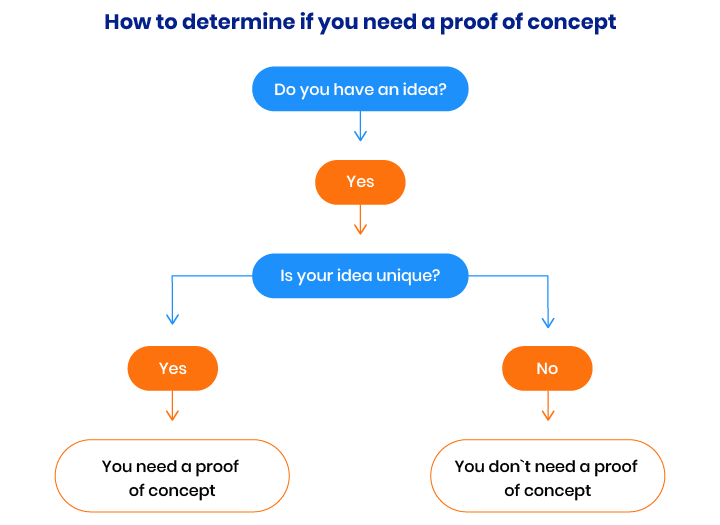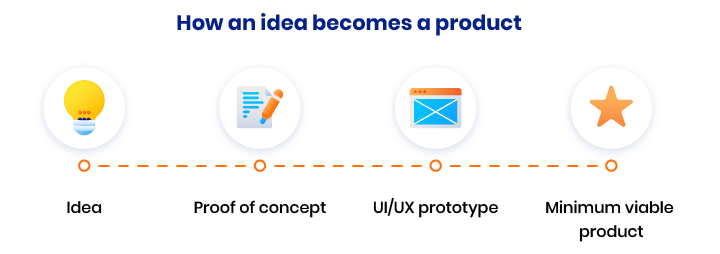-
Product Management
Software Testing
Technology Consulting
-
Multi-Vendor Marketplace
Online StoreCreate an online store with unique design and features at minimal cost using our MarketAge solutionCustom MarketplaceGet a unique, scalable, and cost-effective online marketplace with minimum time to marketTelemedicine SoftwareGet a cost-efficient, HIPAA-compliant telemedicine solution tailored to your facility's requirementsChat AppGet a customizable chat solution to connect users across multiple apps and platformsCustom Booking SystemImprove your business operations and expand to new markets with our appointment booking solutionVideo ConferencingAdjust our video conferencing solution for your business needsFor EnterpriseScale, automate, and improve business processes in your enterprise with our custom software solutionsFor StartupsTurn your startup ideas into viable, value-driven, and commercially successful software solutions -
-
- Case Studies
- Blog
Proof of Concept in Software Development: Is It Worth Creating?
When you have an idea for a new software product or a feature that will take your existing product to a higher level, the first thing you need to know is whether it’s possible to implement your idea in real life. To find out, you may need a proof of concept. In our article, you’ll learn:
- What a proof of concept is and how to decide if you need to create one
- What benefits a proof of concept can provide
- How to create a proof of concept and what to do when it’s ready
What’s a proof of concept?
A proof of concept (POC) is part of a product or design concept that’s aimed at proving your idea can be developed from a technical standpoint. Thus, a proof of concept helps you ensure the feasibility of your idea and decide if it’s worth working on.
Who needs a POC and why should you build one?
Not all startups need a proof of concept. But if you want to build a product with unique functionality or based on a unique concept, you definitely need one. On the other hand, if your website or application is going to have a standard range of functionalities that have proven workable before, there’s no point in creating a proof of concept.

Here are the benefits you can get by creating a proof of concept:
- Ensure the feasibility of your idea. Once you have a workable POC, you’ll know not only that it’s possible to develop your product but also how to do it.
- Choose the most suitable development approach. While creating a POC, you can use different technologies to find the best way to bring your idea to life. Thus, you’ll be able to come up with the most suitable technology stack to build your product or feature.
- Attract investors. A proof of concept demonstrates that your unique idea can be turned into a product that is different from everything else on the market.
In short, a proof of concept allows you to demonstrate just what Jacqueline van den Ende, a partner at venture capital firm Peak Capital, says their firm looks for in new startups:
You need to have a clear story on why your solution is better than what exists, and also how you will execute. We look at both.
Once you decide to start the development of your new product with a proof of concept, keep in mind the essential steps you need to take.
Steps you need to take to create a proof of concept
Here are the main steps you need to take when creating a software proof of concept.
#1 Define the concept you’re going to prove
The main goal of creating a POC is to confirm that a new feature or functionality is possible to implement from a technological standpoint. That’s why you should choose a small part of your software that causes doubts and pick one to three features to develop and test.
Once you define the scope of work for the POC, you can move to the next step.
#2 Make sure the proof is necessary
We’ve already mentioned that a POC isn’t always necessary. So before rushing to create one, conduct research, look at your competitors, and analyze similar products to find out if your idea is truly unique. What’s more, it’s important to look for similar software solutions in other spheres. It may well be that a feature you’re thinking about has already been applied in a completely different market or business sphere.
The GetPet application, which helps people adopt dogs from local shelters, is a good example. The creators of GetPet used a functionality that had already been implemented in Tinder. In GetPet, users swipe pictures of dogs right or left depending on whether they like the dogs ‒ just like in Tinder. For this reason, the creators of GetPet didn’t need a proof of concept for this functionality since they knew it was workable.
However, if there is no similar feature to the one you’ve decided to make, you definitely need a POC.
If your idea isn’t unique and similar features or functionalities have been implemented in real products, you should analyze how those products work. This knowledge can help you improve your idea and create an even better product.
#3 Determine success criteria
To achieve the main goal of your proof of concept — which is to validate the feasibility of your idea — you need to set clear success criteria.
Success criteria include all conditions that must be met to prove that your proof of concept works as it’s supposed to. You should clearly define what the inputs should be and what outputs you expect.
For instance, if you want to develop a system like Google Analytics that collects movement coordinates data in real-time in some building (e.g. mall, airport, university) for analytical purposes, and you don’t know if a certain system architecture and database schema fits your purposes, you want to build a POC to test your hypothesis. The success criteria in that case would be:
- Average database availability time is acceptable;
- Data aggregation speed for a sample report meets the time success criterion;
- Chosen system infrastructure does the work and can be scaled;
- Chosen amount of data is possible to process in a chosen time period to display in real-time.
Once your POC meets such conditions, you can conclude that your idea is workable and can be implemented in real life. If your proof of concept doesn’t meet all the success criteria, it counts as a failure.
#4 Find a team for the job
Creating a software proof of concept isn’t a large task. Depending on the scope of work, it can take from two to several weeks.
If you choose to hire an in-house development team, however, you may spend the same amount of time hiring and onboarding the team as it takes to create the POC. For this reason, consider outsourcing development of your POC to an external team that can create it faster and cheaper. If you’re worried about sharing your unique product idea with an offshore team, sign a non-disclosure agreement to make sure all the information concerning your startup is safe and sound.
Amazon’s experience with a proof of concept
Amazon, one of the largest technology companies in the USA, has a number of software products that they’re constantly improving. In order to develop unique products and add unique features to existing ones, the company uses the POC approach to prove the feasibility of their ideas. This is exactly what they’ve done with Amazon Go shops.
The idea of Amazon Go is to provide a unique shopping experience without queues. Buyers come into an Amazon Go shop, take everything they need, and just leave. This experience is made possible thanks to a combination of sensor fusion, computer vision, and deep learning technologies.
However, before presenting this system to the public, Amazon had to prove the feasibility of the idea. Although the technologies used weren’t new and had already been implemented in self-driving cars and many other projects, they weren’t tested in shops. So Amazon started by testing their idea for several months with Amazon employees. Only after thorough testing and once Amazon had made sure the combination of technologies worked properly, did the first Amazon Go shop open to the public.
After proving their idea first, Amazon now has 26 Amazon Go shops operating in the US and is planning to open thousands of shops worldwide in the future.
What’s next
If you decide to start product development with a POC, you need to know what your further steps should be.

Test your proof of concept
At this stage, you’ll know if your idea is workable. To find that out, you’ll need to assess your proof of concept in accordance with the success and failure criteria you’ve set.
Everything is pretty simple here. If your proof of concept meets your success criteria, it can be implemented in real life and you can move to the next stages. If it doesn’t, you can start creating another POC from scratch or fix existing bugs (if there are any) until the result satisfies you.
Create a UI/UX prototype
Once you’re sure your proof of concept functions as it’s supposed to, it’s time to think about how the whole UI/UX design will look.
It’s important to decide how to visualize your proof of concept to provide a smooth user experience. That’s why you need UI/UX prototyping ‒ a tool that helps you combine unique features with standard ones and choose the best UI/UX design options.
There are two kinds of prototypes you can use: low-fidelity and high-fidelity. Low-fidelity prototypes (also known as paper prototypes) help you get a general idea of how your product or new feature will look. To create a low-fidelity prototype, you just need to take out a sheet of paper and a pencil and start working on your product’s design.
A high-fidelity prototype is a software-based prototype that operates almost like a real product. It’s a clickable version of your future product that helps you detect imperfections that prevent a smooth user experience.
Once you’ve tested your proof of concept and approved the initial design, it’s time to move to the next stage ‒ creating a minimum viable product.
Create an MVP
A minimum viable product (MVP) is a product that has a minimum number of features but still can be launched on the market because its functionality is enough to meet customers’ needs. The aim of an MVP is to gather feedback from your target audience, fix any bugs, and improve your product so you can attract more customers. By doing this, you’re able to gradually develop your MVP and turn it into a full-fledged product.
Final thoughts
A proof of concept is a useful tool that’s necessary if you want to implement a really unique feature. With thorough research and by carefully creating a POC, you can make a technological breakthrough just like world-known businesses have already done.
FAQ
-
It isn’t necessary to create a proof of concept if your functionality or ideas have already been proven in similar software solutions. However, if you have a completely new idea and have doubts about its feasibility from a technological standpoint, you need a POC to make sure it will work in real life.
-
There are four steps you need to take to create a proof of concept:
- Define what feature/functionality you’re going to prove the feasibility of.
- Make sure there are no similar products that already prove the feasibility of your feature/functionality.
- Determine success criteria.
- Find a team to create your proof of concept.
-
When your proof of concept is ready, you need to:
- Test it to determine if it meets your success criteria
- Create a UI/UX prototype of your new feature/functionality
- Move to developing an MVP










